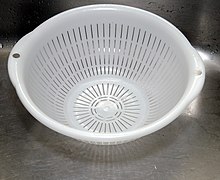Colander
A colander is a household appliance that is used to strain liquids in order to separate solids and liquids from a mixture. The liquid flows through the holes, the solids remain in the strainer. It is mostly used to separate cooked food such as pasta ( noodle sieve ) or vegetables from the cooking water.
The colander referred scenic either a filter cloth or a fine sieve for the discharge of liquids, or the residues which in the cheesecloth were left behind.
In contrast to the verb seven (see: sieve ), the verb siehen (often: sieve ) denotes the clarifying and cleaning of liquids, for example freshly milked milk .
Penetration is a landscape name for a household appliance for pouring off food.
Word origin and history
The sieve (also the siehe ) is derived from the verb siehen , it goes back to ahd. Sîha , mhd. Sîhe and mnd. you, sihe, sige .
The dictionary of the Brothers Grimm leads the Mückenseiher on the spelling Muckenseiher can be demonstrated in a paper by 1,592th In the Italian-German language and dictionary from 1693, different types of colander are listed: colander, colander, colander, colander (leather wine tube) and colander from blotting paper. The colander of blotting paper was also called the hippocras sack (lat. Manica hippocratis ) and was a pyramid-shaped sack made of linen.
Poor people had so-called Seih-rags or Seih-Ridel , that was a rag or tuft of hair through which they strained their milk. The conversation lexicon for the educated stands from 1851 mentions strainers made of wickerwork from basket-making, perforated sheet metal, wire mesh, textile materials, unsized paper (blotting paper), sponge, layers of straw, crushed glass, sand and earth.
Web links
Individual evidence
- ^ A b Karl-Dieter Büntig, Ramona Karatas (Ed.): German dictionary with the new spelling . Isis Verlag, Chur, Switzerland, p. 273, 1045 .
- ↑ Bibliographisches Institut Mannheim (ed.): Der Große Duden - Etymologie . tape 7 . Dudenverlag, 1963, p. 634 .
- ↑ a b Dictionary network - German dictionary by Jacob Grimm and Wilhelm Grimm. Retrieved May 25, 2018 .
- ^ Dictionary network - Middle High German concise dictionary by Matthias Lexer. Retrieved May 25, 2018 .
- ↑ Papist Wetterhan, in twelve different conversations, four from the Latin Eutychii Myonis in Jar 1549, Germanized, eighth brought together for teaching what the Bapsthumb is, and how a Christian should behave towards it according to God's word (etc.) . 1592, p. 328 ( google.de [accessed on May 25, 2018]).
- ↑ Matthias Kramer: Newly made wonderfully large and general Italianisch-Teutsches Sprach- und Wort-Buch, which as well with all actual and natural Red-types, as with good instruction of the correct use of the words, according to their different meanings , Position, and comfortable listing, generously provided, with which art words and ornamental speeches ... expanded ... By Matthia Kramern, hoc and rider Germans, Italian, French, Spanish and English language masters . jn transfer Joh. Andreae Endters Seel. Sohne, 1693, p. 231 ( google.de [accessed on May 25, 2018]).
- ↑ Johann Jacob Woyt: Gazophylacium medico-physicum, or, treasure chamber of medicinisch- and natural things: in which all medicinische art-words, (2) internal and external diseases, together with the same remedies, (3) all minerals, Metals, Ertzte, Erden, (4) foreign and indigenous animals belonging to medicine, (5) herbs, flowers, seeds, sap, oils, Hartzte, & c. : (6) all rare specereyen and materials, and (7) much curious kunft-handles belonging to the Mechanic, in a correct Latin alphabet order, explained, presented, and provided with a necessary register . Transferred from Fr. Lanckischens blessed Erben, Leipzig 1709, p. 544 ( google.de [accessed on May 25, 2018]).
- ↑ Johann Andreas Schmeller: Bavarian Dictionary: Collection of words and expressions that occur in the living dialects as well as in the older and oldest provincial literature of the Kingdom of Bavaria, especially its older lands, and in today's general German written language either not at all, or not customary in the same meanings, with documentary evidence, according to the stem syllables etymologically-alphabetically arranged. Letters R and S. 3 . Cotta, 1836, p. 220 ( google.de [accessed on May 25, 2018]).
- ↑ The great conversation lexicon for the educated classes: this encyclopedia of human knowledge includes: the portraits of the most important people of all time, the views of the strangest places, the plans of the largest cities, 100 maps for old and new descriptions of the earth, for statistics, History and Religion .... Section 2: O to Z; Vol. 8, Type casting - Sidney (Geogr.) . Bibliogr. Inst., 1851, pp. 867 ( google.de [accessed on May 25, 2018]).
